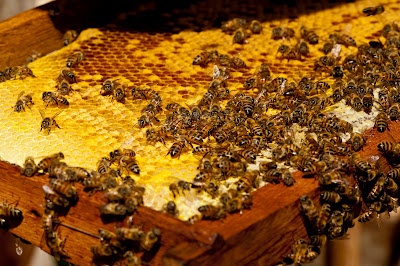What a buzz!
 |
| Credit: Jonathan Wilkins License |
“Bees are environmentally friendly and so are beekeepers.” Thomas Carroll, Msc. (Agr.)*
Haron
has been investigating the practice of beekeeping at Loisaba…
There
has been a long tradition of beekeeping at Loisaba, where members of the community
have put up natural hives, hanging them high up in the acacia trees along the
Ewaso River in order to avoid predators. This method is sustainable and
environmentally friendly, requiring little labour or financial input. Traditionally,
many Kenyan tribes have collected honey and they are reputed to listen for the
call of the Honey Guide Bird so that they can follow it in search of hidden
hives.
 |
| Credit:Olelarpai Kasintere |
The
hives are long cylinders, made from logs or thatched with grass, and occupied
by local bees, attracted by the ready- made home and supply of honey. This form
of bee keeping is low risk and low cost, making the most of the bees natural
behaviour and natural adaptation to the environment, as well as local
materials. The community harvest the honey for domestic and medical purposes,
selling off any excess locally, thus benefitting economically too. However, the
bees wax and propolis which is produced is not harvested even though both are
valuable, and propolis is thought to have many healing properties itself; this
is a form of glue that the bees produce by mixing saliva and beeswax with exudate
gathered from tree buds and sap flows, used to seal unwanted gaps in the
beehive.
The community use honey to treat eye diseases, asthma, hiccups, fatigue, ulcers, sore throats, and to heal wounds, something that has always been of interest to Jo (Silvester) who is a keen botanist and believer in natural remedies.
“About
five years ago, the Conservancy itself invested in
modern, modular beehives, which are looked after by beekeepers, Lomadok and
Omuse. They have set the hives
up in strategic places where there is optimal bee fodder, close to water but
away from the river itself.”
“The hives were populated by wild indigenous swarms, attracted by bees’ wax, which meant that they were resistant to disease, and unlike imported bees, do not bring in new diseases.”
“Once the hives were strong, a super (top) box was added to the original hives so that the honey could be harvested – about 70% of them now have supers on them. A honey super consists of a box in which the beekeepers hangs 8–10 frames, and since the combs are fixed to the four sides of the frame, they are much easier to harvest than a traditional hive. The queen bee soon learns to stay in the lower box so that she and her offspring are undisturbed.”
 |
| Credit: Haron Ayuka |
 |
| In the making Credit: Haron Ayuka |
“The bees are attracted to the acacia trees – notably Acacia Mellifera – which produce the white honey which is supplied to small Kenyan markets and restaurants. The bees also produce honey from Croton trees which is less palatable – and less marketable - having a strong medicinal flavour. Indeed, it has excellent medicinal properties and is good for sore throats and as a skin ointment.”
The
greatest risk to all of the bees is from predators - those that like to eat honey
and those that like to eat bees! To begin with, Jo’s hives were attacked by
Honey Badgers– an animal renowned for its strength and ferocity. They were also
invaded by wax moth, an insect that lays its egg in the wax and eventually destroys
it. Such attacks bring a risk that the bees might pack up and leave in search
of another home, but fortunately, things have settled down.
* Author of A Beginners Guide to Beekeeping - a glorious account. Also apiconsult







Comments
Post a Comment